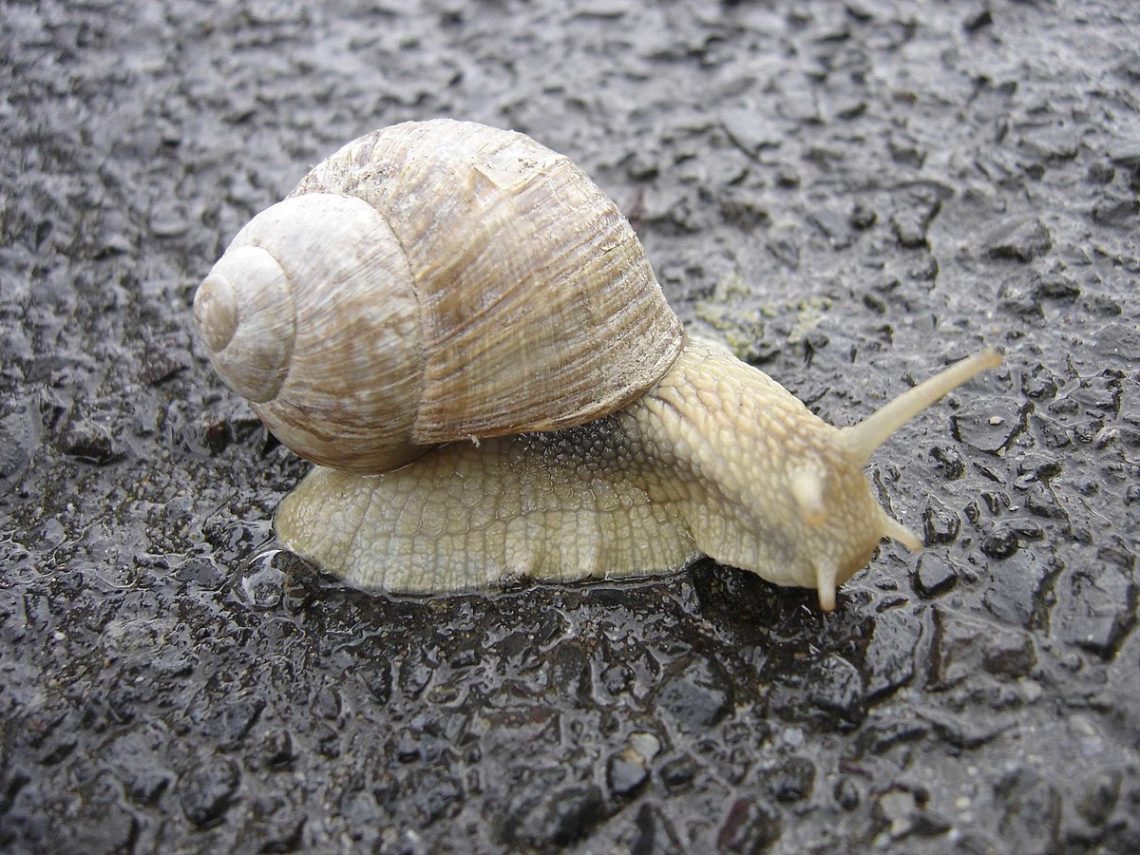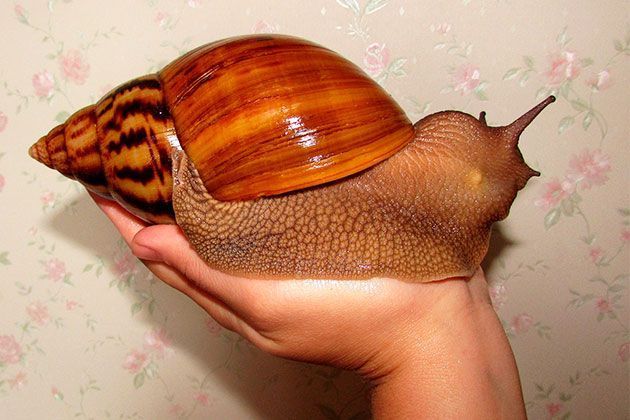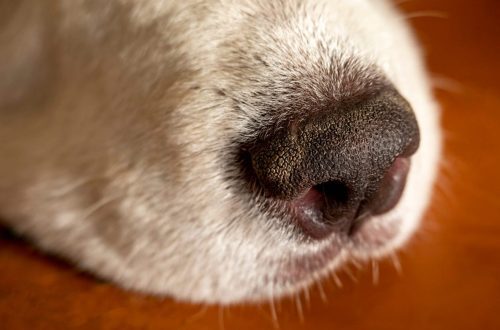
घरेलु... शंख ?!

To date, snails are popular pets, beautiful and interesting behavior. There are many types of domestic snails, from tiny to large and heavy. The content and some types of domestic mollusks are in this article.
सामग्रीहरू
घोंघा सामग्री
Tropical snails need warmth and humidity to thrive. A glass aquarium or a plastic container of a horizontal type for land snails, and a vertical one for wood snails, always with a lid, can serve as a home for snails. For large species of snails, a catch on the lid of a container, or a heavy object on the lid of a glass aquarium, is desirable, as the snails can move the lid and travel unsafely around the apartment. Ventilation openings are located above the ground and on top, but not in very large numbers, so that the humidity of 60-90% and the temperature of 24-27C are maintained inside. The volume of the terrarium should be such that the snail can comfortably turn around in it, and, crawling along the lid, does not touch the ground with a hanging shell.
- Under conditions that are uncomfortable for the snail, they can seal the mouth with a film (epipragma) and hibernate – this should not be allowed for tropical snails. The longer the snail is in hibernation, the less likely it is to wake up, adjust the conditions, check all the parameters. To wake up the snail, turn the shell upside down and spray it on the film cap, or place the snail in lukewarm water, no more than 1 cm deep, with the mouth down.
Soil – finely moist coconut substrate or neutral peat, it is also good to use oak, birch, hazel leaf litter as an addition, any kind of moss, such as sphagnum, twigs and hardwood bark, unground cork bark in a single piece, pieces of rotten wood may be suitable hardwoods. The layer of soil should be such that the snail can fully dig into it. As necessary, you can spray the walls of the terrarium and the soil with water from a spray bottle. In the terrarium of large species of snails, you need to clean up every day or every other day, removing feces and food debris, otherwise an unpleasant smell will appear, and even midges. In small species, cleaning as it gets dirty, it is worth replacing food daily to avoid spoilage. A complete replacement of the soil is carried out as it becomes contaminated. Once every few days, you need to wipe the walls of the terrarium from mucus and adhering soil, for this you will need a separate clean sponge, in no case use the one that you wash the dishes with or clean the sink – snails can be poisoned by the remnants of detergents.
- In no case should you use paper napkins, newspapers, pebbles, large stones, shells, sand, flower soils, soil from the garden, hay, straw, sawdust as soil – all this can harm the pet’s health.
It is not necessary to bathe snails. If you started a general cleaning or just want to take a picture of a snail, you can bathe. To do this, you will need a clean, shallow container, boiled or settled water slightly warmer than room or room temperature, and a soft-bristled toothbrush or sponge. Pour water into the container so that it does not reach the spiracle, put a snail there and carefully water it from above (you can take a clean sponge, wet it in the same container and wring it out), the sink can be cleaned of dirt with a brush or sponge, avoiding growth, especially if it is a young snail and the growth is fragile. Very small snails do not need to be bathed, and even dangerous.
घोंघा पोषण
All snails and slugs feed mainly on plant foods with a small amount of protein supplements, with the exception of predatory species. The diet consists of zucchini, pumpkin, carrots, lettuce, apples, pears, tomatoes, bell peppers, sweet potato, cucumbers, bananas, apricots, peaches, mangoes, strawberries, cauliflower, broccoli, Beijing cabbage, squash, spinach, watermelon, and mushrooms – champignons are best eaten, they can agree on white, boletus and boletus. In summer, weeds can be given, collected far from the roads and well washed – burdock, wood lice, dandelion leaves, plantain, clover; leaves of apple, maple, linden, oak, raspberry, birch. Many snails are very fond of and eat yellow lichen – xanthoria, and for some species, lichen is the main food and should be kept in the terrarium on an ongoing basis. It is advisable to put food for snails in a bowl, small plastic bowls for cats, rodents or plastic trays for flower pots are great. Snails do not need to put water, they get moisture from food and licking from sprayed surfaces, and the bowl is often turned upside down, the water spills, turning the soil into a swamp. If you want to arrange a pool for snails, it should be heavy and stable. Protein supplements are dried crustaceans – daphnia and gammarus, given to a limited extent. Mineral supplements are required – ground or lumpy fodder chalk, shell rock and egg shells ground into dust, cuttlefish shell (sepia). Top dressing can be poured both on food and put in a separate bowl. Young growing snails of any species need to be fed daily. In the evening, thinly slice fresh vegetables, sprinkle with calcine mixture, add protein supplements (growing snails can be given a little protein every day, because they have a higher protein requirement than adults). Adult snails may eat less often, and they can be fed less.
You should not feed domestic mollusks with food from your table: no pasta, cookies, potatoes, soup, sausages, bread, any salty, fried, fatty, sour and spoiled foods should not be in the snail’s diet. In addition, mineral blocks for birds and rodents should not be offered as a source of calcium.
Snails are nocturnal animals, they should be fed in the evening when they wake up.
Diseases and injuries of snails
Snails, like any other living creature, can get sick. The main causes of diseases are improper conditions of detention, careless handling.
- Overheat. The snail becomes lethargic, swollen, slow, covered with excess mucus, refuses to eat, goes deep into the sink or lies like a “cloth”. Direct sunlight is especially dangerous, so you should never leave containers with snails in the open sun. Prolonged or sudden strong overheating often leads to the death of the snail.
- Thermal burns. When washing the snail, cool water should be used, and any heaters and lamps should be out of the snail’s reach. The burn is accompanied by damage to the soft tissues of the cochlea, the formation of wrinkled areas and blisters. The mollusk becomes lethargic and inactive, does not use the burnt part of the body for movement. If the burn on the tail, leg and not very large – after some time it will heal with the formation of a dark scar. If the head is burned, or tissue necrosis has begun, accompanied by an unpleasant odor, the outcome can be sad.
- Chemical burns. You should not let the snail crawl freely, leave it in the sink or bath, apply various detergents and chemicals to it. A snail burn can be obtained when the body is exposed to household solvents, detergents and washing powder, soap, lotions, cosmetics, alcohol, hydrogen peroxide, vinegar, etc. The symptoms are similar to a thermal burn.
- Bites by other snails. This also happens, with a lack of nutrition and protein supplements, crowded content, heavily polluted soil, one snail can gnaw on the body of another, scraping off the upper part of the “skin” of the snail, leaving white, eaten marks. Most species are capable of cannibalism. If they gnaw on a smaller and weaker snail, they can eat it completely. After the bites heal with the formation of light or dark, almost black scars, restoring the entire texture of the body, and even parts, for example, can grow back an eye or tail. When biting in a terrarium, you need to eliminate the source of stress and establish conditions and nutrition.
- Prolapse of the mouth and stomach, prolapse of the penis. The exact cause and effective treatment of these diseases in snails is not known. When the mouth falls out, the digestive organs turn out, the pharynx, stomach in the form of a mucous bladder filled with a clear or blue liquid, it can help reduce pressure in the bladder, puncturing the bladder wall and repositioning the organs in place, but, unfortunately, if it fell out once, it will fall out again and again. When the snail’s penis prolapses, it is located outside, on the side of the head, and the snail cannot set it on its own. It happens that within 1-2 days the genital organ falls into place on its own, but it also happens that the snail injures it on objects, begins to gnaw itself, and the organ may begin to die. In order to avoid the death of the snail, amputation of the penis may be required; its absence will not greatly affect the further life of the snail.
Shell damage. With careless handling and violation of the rules of maintenance, the shell may break, become thinner, and become covered with scratches. Frequent damage:
- Growth breakdown. The growth is located near the mouth of growing young snails and is a thin film, usually yellow. Most often, it is injured by fingers when the snail is not picked up correctly, and it also breaks when falling from the lid, and can be crushed on the edge of the bowl and even on the neck of the snail itself. It overgrows quickly, leaving a mark on the sink.
- Breakage of the apex (shell tip) and other parts of the shell. The apex often breaks without human intervention, especially in older large Achatina, in which the apex is small and thin. It can also break in young snails, especially with insufficiently good nutrition and high humidity in the terrarium. Large coils break off when falling on hard surfaces, when the shell is thinned due to high humidity, dirty marshy soil, or nibbling by other snails. If the breakage is small, it is not necessary to do anything, the snail will overgrow the chip from the inside. If the shell has broken badly and soft organs are visible, you can try to restore it by sealing the chip with eggshell film and fixing it with adhesive tape, the outcome may be unfavorable.
- Scratches and stains on the sink. They are found in older snails, due to age, the conchiolin layer is erased and white scratches remain. May appear when kept on hard ground, gravel, pebbles, sand, in conditions of high humidity and pollution. Only the appearance suffers, usually wear and scratches do not interfere with the snail itself, unless the shell is so worn out that it has become thin and fragile.
Types of domestic snails
Almost any snail can be kept at home, given the characteristics of their content. Tropical terrestrial molluscs need warmth and moisture, woody mollusks need warmth, moisture, twigs, mosses and lichens, midland snails need periods of drought and humidity, as well as hibernation, middle lane slugs need moisture and cool temperatures. Consider the most popular types of snails kept at home.
अचातिना
Achatina – a genus of tropical land snails, includes many species from very small to huge. They have a conical elongated shell with a pointed end (apex, top of the shell), a soft, almost textureless body, from beige to dark brown, albinos are often found, they secrete quite a lot of mucus. They lay small oval eggs in a dense shell from 50 to 400 pieces at a time, small snails hatch in 2-4 weeks, feeding on the remains of their eggs for the first days, later crawling around the terrarium in search of food. There are also ovoviviparous species, such as Achatina iredalei, the eggs develop inside the snail, and already formed snails are born, in this case the number of clutches is much less. Achatina fulica is the most common species. It has a smooth shell up to 20 cm long, usually smaller – 12-15 cm, mostly brown shades, it can also be almost black, greenish, yellow with indistinct stripes or without stripes. It has a rather soft and smooth body from light beige to dark brown, albinos are often found. Achatina reticulum. One of the fastest growing and largest species, with a thin ribbed shell that grows to 18 cm with good care, and can even be larger, and a soft body – from light beige to brown with a black head, or albinos. Achatina was irradiated. A small species with a light soft body and a yellow shell 5-7 cm. length. Produces formed independent snails in the amount of 15-25 pieces. Achatina panther. The body of this snail has a reticulate pattern of dark veins, a light beige to deep auburn color, and a dark neck band from the head to the shell. The shell is smooth, 10-12 cm long, brown or reddish in color; with age, the conchiolin layer may peel off, and the color of the shell will become lighter. Achatina the Immaculate. The body is very similar to the body of the Achatina panther, but the shell is more rounded, dark, with a small zigzag pattern, 9-12 cm long. Achatina croweni. Another medium-sized representative of the genus Achatina. The size of the shell of an adult reaches 5-7 cm, the color is beige, yellowish, the surface is smooth. From the earliest coils, the shell is decorated with solid or intermittent longitudinal brown stripes. Just like Achatina iradeli, it produces “ready” snails. Achatina Achatina, or “tiger”. The body is from beige to almost black in color, the leg structure is dense, granular texture, the leg is notable for the “crocodile” tail. The tiger is the only representative of the Achatina genus to have such a tail. Albinos are also common. The shell is smooth, on average 12-14 cm, in domestic mollusks there are individuals up to 15-16 cm in size, the record size of the shell of a natural specimen is 28 cm (this size is officially recorded in the Guinness Book of Records). The shell has very bright contrasting yellow-black stripes.
Archahatins
A genus of land snails, from small – 5-7 cm to large – 15 cm species. Distinctive features are a rounded tip of the shell, a dense textured body and a “crocodile” tail. They lay 5-15 eggs at a time, large, snails also come out large and developed. Arkhachatina marginata ovum. Dense textured body, from light beige to dark brown, there are also albinos, “Acromelanics” – with a white body and gray horns, and “Silvers” – with a silver-gray body. The shell is heavy, of various shades of ocher, yellow and red, with dark stripes or speckles, 12-14 cm long. Archachatina marginata suturelis. They look like Ovums, the colors are the same, the shell is more elongated, bright and has a pink tip. Archachatina papiracea. Shell: 6-8 cm, the first coils are painted in brown-beige tones, striped, a large coil is monochromatic – brown or greenish. The body is soft, ends with a crocodile tail, somewhat less pronounced than in snails of the genus. A brown stripe runs along the neck, the color varies from beige to brown. Arhachatina puilaherti. The body is soft, spreads over the surface when moving, has a crocodile tail, but somewhat less pronounced than in other archachatina. The color of standard individuals varies from beige to dark brown, a brown stripe runs along the neck. Albinos are most often found in collections. Arkhachatina egregia. The shell is 8-10 cm, bright, usually with a predominance of dark tones, the texture is smooth. The body is rather rigid, dense, has a crocodile tail. The color of standard individuals varies from beige to dark brown, sometimes almost black. The horns and head are darker colored than the body, usually the dark gray or dark brown color of the horns fades into a brownish-beige color of the legs and ends with a beige tail, albinos are also common. Arkhachatina marginata marginata. The shell is massive, round, thick-walled, on average, 10-12 cm, has black and white longitudinal stripes. It peels off with age, the shell becomes dull and whitish with a greenish tint, but no less spectacular. The body is dense, black or dark brown, with a granular texture, usually slightly lighter towards the tail.
Arboreal and other small snail species
Unusual looking small snails that prefer crawling on the ground twigs and walls of the terrarium. For their maintenance, you need a high terrarium, with soil, litter, and, of course, with branches with lichen. Eggs are laid in the ground, often soft-shelled, 5-15 eggs at a time. Tree snails in nature live in colonies, it is not recommended to keep them alone. Karakolus. Bright snails with a round flat shell about 5 cm in diameter, decorated with stripes, can be found in monochromatic, almost black, and white shells. The body combines black, silver and red shades. Pleurodont Excellence. Relatively large snail, up to 7 cm in diameter, with an almost black flat shell, black-orange body and white bands on the stalks of the eyes. Pleurodont Isabella. A small species of snail with a black-gray body and a striped shell, there are also variants with a white and light ocher “amber” shell, about 2 cm in diameter. Pseudo-Achatina leyana. They have a ribbed light shell, elongated, 6-7 cm long, and a bright red body. They grow very slowly, moss and lichen are required in the terrarium. Limicolaria. Small active snails, with an elongated shell 6-7 cm long, white (unicolor color), or light color with dark stripes (flamme), there are also species of lymicolaria with other shell colors, such as pinkish-orange. The thin long neck has longitudinal stripes. Subulina octone. A small species of snails on average 1,5 – 4 cm long. They reproduce very quickly, eggs and snails are about 1 mm. Yellow body color, transparent light yellow shell, strongly elongated. Siamese chemiplectes. Small snails with finely ribbed round shells, yellow or reddish-brown above and white below, and gray bodies. Fast and active.
Megalobulimus
A kind of snail with an ovoid shell 7-8 cm long, amber in young, matte beige, bright pink “lip” in adults – the edge of the shell, and a soft, jelly-like gray or beige body. The most distinctive feature of megalobulimus is their amazing fan of lower tentacles. This is a tactile-olfactory organ that the snail opens to recognize the smell of food, to feel an object, and even to catch water droplets (when it rains in nature or when swimming in captivity). Sexual maturity is reached by 3 years. After mating, 10-12 eggs are laid in pairs, with an interval of 4-5 weeks. The eggs are very large, oval, averaging 2 cm long and 1 cm wide. From food they prefer lettuce leaves and soft vegetables-fruits (plums, bananas, mangoes (very ripe), tomatoes), they eat boiled chopped carrots perfectly.
tropical slugs
Most often, species of the Veronicellidae family are kept at home, which have a flattened oval body and a “hood” over the eyes. The eggs are transparent, oval, collected on one thread, like beads, through the shell one can observe the development of the embryo. For the first day, the slug, which laid the clutch, remains near it, wrapping itself around the body, and then leaves and does not return. For slugs, you need a horizontal type terrarium, with coconut soil, moss, and leaf litter. With pleasure they eat lichens and mushrooms, fruits. The terrarium should have a tight-fitting lid, slugs can squeeze into the narrowest gaps, and outside the terrarium they quickly die without moisture.
Snails and slugs of the middle lane
At home, you can also contain mollusks that live in Russia. To keep them, you first need to find out the type of snail, and then where it lives in nature. Conditions should be close to natural. Some species require a summer drought, when moisture and nutrition stop, the snails are sealed with caps and sleep for about 1-2 weeks, then the “rainy period” begins – moisture and nutrition are restored. Most need hibernation, the soil also dries up, food stops, and the snails are placed in a cool place for 1-2 months. Slugs almost always need a cool temperature, high humidity, at high temperatures they quickly die. Grape snail helix pomatia Slug limax maximus Chains Arianta Xeropicty Fruticicola





